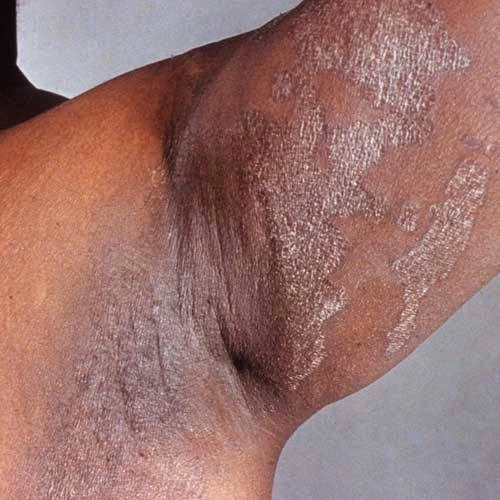Author's details
- Hakim A Abubakre
- BA (Hons) International Business Management, Msc Digital Marketing.
Reviewer's details
- Dr. Khashau Eleburuike
- MBBS (Ilorin) MSc. Global Health Karolinska Institute.
- Resident doctor in family medicine in Northen Sweden.

- Date Published: 2025-09-02
- Date Updated: 2025-09-02
Erythrasma (Skin fold infection)
Erythrasma, also called cutaneous erythrasma, is a chronic bacterial skin infection. It is common in sub-Saharan Africa due to the warm, humid climate.
The condition mostly affects:
- People who are overweight
- People with diabetes
- Those who sweat excessively
- People with weakened immune systems
- Older adults
- Individuals living in crowded housing or shared spaces
It is not life-threatening but can be persistent, uncomfortable, and sometimes mistaken for fungal infections like ringworm or athlete’s foot.
How Does it Look?
Erythrasma usually appears as:
- Reddish-brown or pink patches with well-defined edges
- Slightly scaly, wrinkled, or dry skin
- Mild itchiness or burning (especially in the groin)
- Cracks or softening of the skin in between the toes (can look like athlete’s foot)
- On darker skin, it may appear as lighter patches with darker edges
Common areas affected:
- Armpits
- Groin
- Under the breasts
- Between the buttocks
- Belly button
- Inner thighs
- In between toes
- Folds of excess skin (stomach, legs)
It is more common in men (groin involvement) and in women (between the toes).
Warning Signs and Symptoms
- Red, pink, or brown patches of skin
- Mild itching or burning
- Scaly or wrinkled skin
- Macerated (softened) skin between toes
- Small cracks on the feet
- Rash that resembles ringworm or fungal infection
- In many people: no symptoms at all
Self-Care and Treatment
Most cases can be treated successfully with good hygiene and topical or oral antibiotics.
At home care:
- Wash affected areas daily with antibacterial soap
- Keep skin clean and dry, especially in folds
- Wear loose, light, cotton clothing to reduce sweating
- Use baby powder to keep skin folds dry
- Eat a healthy diet and maintain a healthy weight
Medicines that may be used (prescribed by a healthcare worker):
- Topical antibiotics: Clindamycin cream, Erythromycin cream, Fusidic acid cream, Mupirocin cream, Whitfield’s ointment
- Oral antibiotics (for widespread or resistant cases): This should be prescribed by a doctor to limit the growing antibiotic resistance
- Benzoyl peroxide wash to reduce bacteria
- Mild steroid or antifungal creams (e.g. hydrocortisone, miconazole) for itching or irritation
When to Seek Medical Attention
See a healthcare worker if:
- You notice reddish-brown patches in moist areas that do not improve with self-care
- The rash spreads, worsens, or looks like ringworm
- You have diabetes or a weak immune system and notice new patches
- You develop fever, pain, or spreading infection
- The skin blisters, peels, or becomes severely irritated
- You have severe symptoms like breathing problems, swelling of the mouth or face, or widespread rash
Prevention
- Bath or shower daily, especially in hot weather
- Keep skin dry and clean, especially folds
- Wear loose cotton clothing that absorbs sweat
- Avoid staying in very hot, damp conditions for long periods
- Manage weight to prevent obesity
- Control blood sugar if you have diabetes
- Do not share towels or clothing in crowded settings
Key Points
- Erythrasma is common but often overlooked in sub-Saharan Africa.
- It is caused by bacteria, not fungi, though it may look like fungal infections.
- Good hygiene, early treatment, and prevention strategies can help control the disease and reduce recurrence.
- Hay RJ, Johns NE, Williams HC, et al. The Global Burden of Skin Disease in 2010: An Analysis of the Prevalence and Impact of Skin Conditions. J Invest Dermatol. 2014;134(6):1527-1534.
- Grice EA, Segre JA. The skin microbiome. Nat Rev Microbiol. 2011;9(4):244-253.
- James WD, Berger TG, Elston DM. Andrews’ Diseases of the Skin: Clinical Dermatology. 13th ed. Elsevier; 2019.
- Okeke IN, Peeling RW, Goossens H. Skin Infections in the Tropics. Lancet Infect Dis. 2020;20(8):e156-e165.
